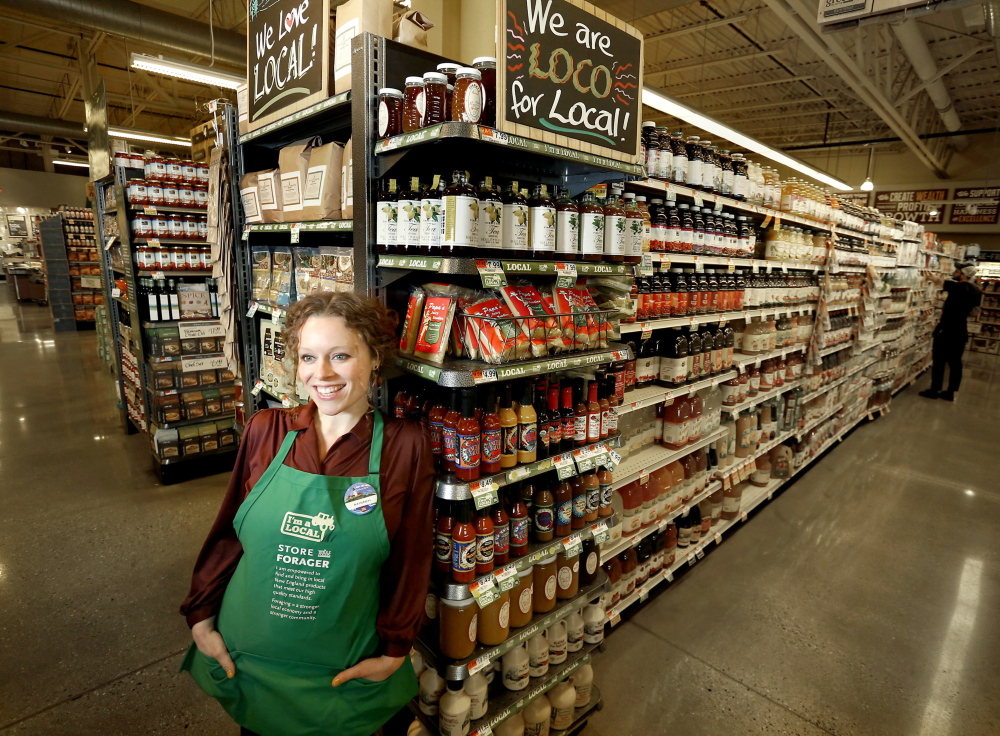Kristen Bartlett, 33, is the “local forager” for Portland’s Whole Foods Market. When artisans who make their own jam or hot sauce dream of finding a larger audience, she’s the person they turn to in hopes of getting their products on the store’s shelves.
Is this a problem for her at parties? Is she swarmed by local farmers, waving organic broccoli and apple butters? Not yet, she says, though she wonders what will happen after her photo is published in Source.
NUMBER OF INQUIRIES BARTLETT GETS EVERY WEEK: Four or five.
NUMBER OF LOCAL PRODUCTS THE STORE ACCEPTS EVERY YEAR: On average, 30 to 50.
HOW THE PROCESS WORKS: “First of all, it’s not just the forager who makes decisions on local products,” Bartlett said. “We work as a team. I’ll be the person the potential supplier will come to first, and then I will decide what department it will fit best into, and I’ll include that team and their buyer. Maybe we’ll do a phone conversation with the buyer, or maybe they’ll come in and we can sit down with them and taste their product. If a buyer decides that it would be a good fit for their department, that’s all I need to know, and then I start the paperwork process.”
PERCENTAGE OF LOCAL PRODUCTS THAT ARE EDIBLE: 80 percent.
NOTABLE RECENT FOOD SUBMISSION: Litl’ Squirts, a fruit juice made with Maine spring water intended for children. “It’s cute. It comes in a little bottle.”
RECENT NONFOOD SUBMISSIONS: A line of gluten-free supplements. “We have some wool dryer balls called LooHoo that are locally made,” Bartlett said. “And the owner’s name is Cindi, so she’s Cindi LooHoo.”
HOW SHE KEEPS IN TUNE WITH WHAT THE PUBLIC WANTS: “I shop here, for one, so I am a customer and I can see things from that perspective. I know what I want. I have a lot of friends who are foodies. I go to farmers markets. When I travel, I’ll go to local natural food stores to get ideas. I like to scout things out, things that our store doesn’t have yet. I go on social media, too, and to foodie events.”
THE PORTLAND TRIFECTA: Bartlett keeps her eyes open for products that will appeal to Portland customers. “The other day this woman came to the counter and said ‘I have these lobster biscuits that are made locally. They’re lobster-shaped dog biscuits that are made out of blueberries.’ They sounded so good to me, I took a bite right out of one of them. It wasn’t half bad. Our customers love blueberries, they love lobsters, and they love their pets, so if we can bring in these biscuits, we will.”
MAKE IT STOP: Jam. “There would have to be something really special about it,” she said. “I love jam. But we have a lot of jam.”
WHAT MAKES A JAM SPECIAL: A good story. Naturally Jammin in Limington, added to the Whole Foods lineup a couple of months ago, was created by a woman whose husband was diabetic and needed to change his eating habits so he could lose weight. She started making apple butter and jams sweetened with honey. Her husband lost 165 pounds, and her friends and family liked her jams so much she began selling them.
ARE PROMISING PRODUCTS EVER A BUST? “Our state loves local products, so I think anything we bring on does pretty well,” Bartlett said. “And we want them to succeed, so we make sure the cost is right for our customers and the product is right before we will put it on the shelf. We’re not going to set them up to fail.”
TWO NEWEST LOCAL PRODUCTS: GoBerry Greek frozen yogurt by the pint (made with milk from Smiling Hill Farm) from Portland and frozen, gluten-free, ready-to-bake pies from Maine Pie Company in Biddeford.
PRODUCTS THAT HIT THE BIG TIME AFTER A PORTLAND INTRODUCTION: Maine Root is now national. Schlotterbeck and Foss’ gourmet sauces and Deer Camp hot sauces are now regional. Little Lad’s popcorn is “expanding through our region like rapid fire.”
PRODUCT THE STORE ITSELF USES: Organic stone-ground grains from Maine Grains are for sale and are used in the store’s bakery to make bread.
WHAT’S ON WHOLE FOODS’ “UNACCEPTABLE INGREDIENT LIST”: There are nearly 80 in all. In addition to a lot of unpronounceable stuff – dimethylpolysiloxane, anyone? – there’s MSG, foie gras, aspartame, artificial colors, artificial flavors, partially hydrogenated oil, high fructose corn syrup and saccharin.
ADVICE FOR PITCHING TO WHOLE FOODS: “They should probably look at our unacceptable ingredient list,” Bartlett said. “They should think about if there’s a story behind their product and be ready to tell us about it. They should think about whether customers in Portland’s Whole Foods Market would want to buy their product. And if there’s … something that would make their product stand out, that’s always a plus. And they should come talk to me. I love suppliers who come in and ask for me at the front desk. It shows me that they want to be in our store, and I like the honesty of a first impression.”
Send questions/comments to the editors.



Comments are no longer available on this story